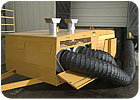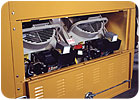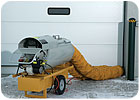
Talk about getting cold feet. Some days it doesn’t matter how many pairs of socks are layered under your boots. Your toes are still numb. To top things off, the project is on a tight deadline (isn’t it always?) and the forecast looks miserable for at least another week.
You can always rotate workers through a shed to heat up. That will only drop your productivity by, say, 25 percent due to increased breaks. Of course, everyone seems to be working more slowly and clumsily than usual due to the cold. Better make that a 40 percent drop. Oh, and some equipment won’t start, so you’ll have to haul it to a building to warm it before work can continue. We don’t even want to talk about the productivity level at this point.
The fact is that working in a cold-weather climate can really take its toll on workers, equipment and productivity levels. Everything tends to slow to a frozen halt. Fortunately, there are plenty of jobsite heaters available to purchase or rent, which could help remedy the problem, but where does someone start in selecting a heater? There are 60,000-Btu heaters, 1 million-Btu heaters and numerous choices in between-and knowing that a Btu is the amount of heat needed to increase the temperature of a pound of water by one degree really doesn’t help. Should it be gas, diesel, propane or natural gas? Direct fired or indirect fired? What if there’s a tarp around the work area? Will that make a difference?
You can’t take a one-size-fits-all approach to buying or renting a heater. The area size and application should dictate the best option. Some jobs will be almost entirely exposed and require a heater to improve worker comfort and productivity while others will be enclosed and require heat for more than human productivity reasons. A number of applications require heat, such as drywalling, brick laying, plastering and pouring concrete. Some sites will require “clean heat,” while others won’t.

Types of Heat
When talking about types of heat produced, the industry boils it down to two categories: direct-fired heaters and indirect-fired heaters.Direct-fired heaters operate on a variety of fuels, which produce a flame. A fan behind the flame blows the hot air in the direction needed. The benefit of this type of heat is that it is the most efficient form. There’s nothing between the flame and the area being heated-such as ductwork-so the most heat can be directed to the site.
The lack of a barrier between the flame and the jobsite also presents the downfall to direct-fired heaters. Besides all of the heat making it to the jobsite, so do all of the contaminants and fumes from the burning combustion of the fuel. Since the combustion process takes place in the open, the products of combustion mix in with the heat. When it comes to heating an enclosed space, this type of heater could pose a danger to workers. The fumes and contaminants would be of little concern, however, when using the heater in an open area to warm a piece of equipment.
In addition to contaminants from a direct-fired heater, moisture poses another problem, which can wreak havoc on some applications. For instance, green-treated lumber, which is often used in framing, is considerably wet to begin with. Additional moisture absorbed from the heater may cause the wood to swell. As it dries, it will shrink, causing warping, cupping or twisting. Any way to eliminate moisture-rather than add to it-in a framing application will improve the work quality as moisture in wall cavities becomes less of a problem.
Another application where the moisture of direct-fired heat causes a problem is drywalling. Joint compound releases moisture into the air as it dries, so added moisture from the heater could cause condensation and slow productivity. A direct-fired heater’s expended moisture also adds a considerable amount of time to curing concrete, drying paint or hardening brick mortar.
Indirect-fired heaters enclose the flame and, in essence, reverse both the benefits and drawbacks of the direct-fired heater. Called “clean heat,” the indirect-fired heat is produced through convection, filtering the products of combustion so that breathable, contaminant-free air reaches the work area. The convection process provides clean, breathable heat through ductwork to an enclosed area, eliminating the side effects that accompany direct-fired heat.
Though indirect-fired heaters expunge contaminants and fumes through a chimney system, some heat also is lost through the chimney. This prevents indirect-fired heaters from achieving an efficiency rating as high as that of direct-fired heaters. Contrarily, indirect-fired heaters can remove excess moisture from the air, which will accelerate drying and curing applications.
Calculating Btu
While choosing a heater size isn’t an exact science, some relatively simple math skills can give a contractor a good idea of the amount of Btu-or British thermal units-needed. Begin by determining the cubic area of the space you plan to heat-multiply length, width and height.Next, subtract the minimum outdoor temperature from the maximum indoor temperature sought. For instance, if the mercury falls to 30 below zero outside and the area should be heated to as much as 45 degrees inside, the difference is 75.
The final number needed-heat loss-can be a little trickier to determine. It depends on the level of insulation, the number of doors and windows and any other covering that may be present. Calculated as a U-value, or the sum of heat lost through the combined materials of the site, every job likely will be different. Begin by determining the R-values of the sheltering materials-the level of thermal resistance or conductance for each material type on site. For instance, the R-value of 3/4-inch plywood is 0.47 and the R-value for 3.5-inch fiberglass batting is 11. The total R-value for an area constructed of these materials would be 11.47. Next, determine the U-value, which is the inverse of the R-value and represents the total heat lost. In this case, the U-value equals .087 (1 divided by 11.47).
Multiplying each of those three calculations together-cubic area, temperature difference and heat loss value-will provide the minimum number of Btu needed to achieve the desired temperature. In the given example, the U-value of .087 multiplied by the temperature difference of 75 determines that 6.525 Btu are being lost through each square foot of the structure. A 10,000-square-foot building would have a total heat loss of 65,250 Btu, so a heater that size or larger would be necessary to reach the desired 45 degrees. While doors and windows can be worked into the equation based on each item’s size and composition, it complicates the math more than is necessary for getting a generalized estimate of what’s needed. Instead, work an additional 20 percent into the equation to account for heat loss through any ventilation system, door or window. For assistance determining heat loss, consult with a dealer, equipment manufacturer or rental center once information regarding the application is available.
While calculating the amount of heat needed, take time to consider the amount of ductwork that will be required if an indirect-fired heater is used. The closer the heater can be placed to a jobsite means the less ductwork that will be required and the less heat that will be lost. Since ductwork typically isn’t insulated, a considerable amount of heat could be lost when trying to run significant lengths.
Besides the concern of losing heat through ducting, pressure also will drop. Since ductwork constricts air volume, using more sections of ductwork will result in a greater pressure loss before the heat reaches the jobsite. For the most efficient operation, use the least amount of ductwork possible.

Additional Considerations
Besides heat type and size, numerous other components may affect the choice of a heater. Based on specific application, some features may be more important than others. For instance, consider the level of portability needed. Some manufacturers offer units that are completely self-contained-heater, fuel and equipment on a trailer-and easily can be towed by a three-quarter ton pickup. Other units may need to be loaded and unloaded from a larger truck or trailer with a crane or skidsteer. Likewise, some units feature wheels for easy portability around the jobsite, while others do not. Determine which will be best for the given application.Along with portability, consider the level of convenience needed. Some units, such as self-contained models, have an extremely short setup time. This might be a necessity for jobs on a tight deadline. Others could need some plumbing done or extra tanks brought in before the heater will be operational.
Another consideration should be the type of fuel most readily available. To simplify operation and preventative maintenance, look for a diesel-powered heater on a diesel-ready jobsite, for instance. Some sites in municipal areas may have natural gas hookups, which would make a natural gas heater ideal.
Consider the work area’s elevation. Air gets thinner with increases in altitude, which negatively impacts the ability to burn fuel. At higher altitudes, use a nozzle that delivers less fuel so the fuel-air mixture needed for combustion will be at more equitable levels.
Look for a fuel tank sized for convenience-the larger the better. Some units feature tanks large enough to continuously power the heater for more than 24 hours without requiring refueling, saving valuable time. Also check for easy-to-use controls, which will shorten the learning curve and time involved in operating the heater.
If the heater is self-contained and includes a generating set, make sure it includes self-protection features that will prevent engine problems that could cause costly damage. Some options to look for in this regard include an automatic shutdown for low oil pressure or high temperatures and fuel pressure gauges. Given the nature of the environment that heaters work in, ensure that the machine has been equipped with cold-start aids.
Keeping the application in mind will make selecting the best heater for your purposes simpler. Before making a decision, take some time to consider what’s being heated-employees, equipment, materials or all of the above-the size of the area, the location and ductwork needed and other features that may be a necessity or simply a convenience.
There’s really no reason to have cold feet about buying or renting a heater-or to keep taking the heat from your shivering employees. It’s just a matter of a bit of education and taking that first step-numb toes or not.
